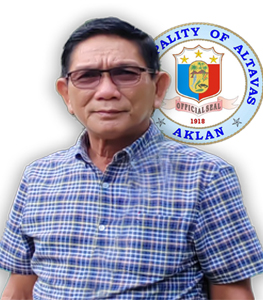HISTORY OF THE MUNICIPALITY OF ALTAVAS
Altavas is a small mountainous town located in the easternmost part of the Province of Aklan and is considered as the gateway of the province from other provinces in Panay Island specifically Capiz and Iloilo.
A hundred years ago, Altavas was just like one of the many barangays existing today. It was part of the town of Batan and also under the jurisdiction of the municipality of New Washington (formerly called Lagatic). If Altavas, as it is today, has achieved the status of a regular municipality, it was purely accidental. It was the result of the constant threat of Moro pirates among the inhabitants along the seashore of Batan. Fearful of being molested by Moro pirates, they moved inland and settled in the place, which is now the Poblacion of Altavas. These evacuees later became the nucleus of the present population of the town.
Notable among the prosperous inhabitants were the two brothers Felix and LaureanoCandelario, believed to have come from either the province of Capiz or Iloilo, to trade and barter. These two brothers, although illiterates, were good-natured and very industrious. They cleared the forested area in what is now called Barangay Catmon and planted it with abaca, native pineapples, beetle nuts and other crops in demand at that time. They became rich and well known. The people loved them for their philanthropic activities. Because of these, the authorities of Batan appointed them “Cabezas de Barangay” and later on “Tenientes Mayor Absolute”. With their own initiatives, expenses and support from the people, they cleared the old site of Batan, laid out streets, constructed a church, school, building and other government buildings then named the place “LaguingBanwa”. History puts it that LaguingBanwa was the original town settlement of Batan.
During their term of office, the authorities in Batan were very exacting to the people of LaguingBanwa. Although illiterates, the two brothers were endowed with patriotic hearts. Again, at their initiative, they assembled the people and raised their concerns for the unjust treatment they received from the authorities of Batan. They initiated a petition to the Brigadier-Governor General for Visayas and Mindanao and to the Bishop of Cebu urging that LaguingBanwa be given the status of a regular municipality. It was at this juncture that the Spanish government issued a decree requiring the inhabitants to pay the amount of money called “tribute” as one of the conditions in the creation of the municipality. Aside from this, the formation of twelve (12) barangays with a population of twelve (12) families paying tributes was another condition set in creation of the town.
The two brothers assembled the people and presented all the requirements. They promised to answer all the deficiencies in the tributes. They conducted a census of families, organized the barangays and appointed among others, Don Gregorio Mariano, Andres Venancio, Maximo Victorio and Tomas Pesante as “Cabezas de Barangay”.
After all the requisites were complied, all papers and documents were forwarded to the Brigadier-Governor General in Cebu who signed a “Decree” separating LaguingBanwa from the town of Batan, with a condition that the town be named “Jemino” after Monsignor Jemino, the Bishop of Cebu, whose influence greatly helped in the early approval of the petition. The first “Captain” was Felix Candelario who was later succeeded by his brother Laureano.
Jemino existed as a regular municipality until after the Spanish-American war. During the American regime, the Philippine Commission reorganized all the towns in the Philippines and the towns of Jemino, Batan, Balete and Lagatic (New Washington) were merged into one municipality with Lagatic as the principal seat of government.
In 1917, the people of Jemino filed a petition with the Philippine Assembly through the Hon. Leopoldo M. Alba, representative of the 2nd District of Capiz and Senator Jose Altavas of the 7th Senatorial District, asking for the separation of Jemino from Lagatic and be given a permanent status of a regular municipality. The petition was given due course and in no time, the town of Jemino was recreated but its name was changed to “Altavas” in honor of Senator Jose Altavas, who was greatly responsible for its separation.
Altavas now exist as a 4th class regular municipality (1991 classification), and one of the seventeen (17) towns of the Province of Aklan when it separated from the Province of Capiz on April 25, 1956, due to the approval of the bill for its separation introduced then by the late Congressman Godofredo P. Ramos (first Congressman of the Province of Aklan) and signed into law by the late President Ramon Magsaysay.
The Municipality of Altavas is divided into fourteen (14) barangays namely: Poblacion, Cabangila, Cabugao, Catmon, Dalipdip, Ginictan, Linayasan, Lumaynay, Lupo, Man-up, Odiong, Quinasay-an, Talon and Tibiao. The Poblacion is about an hour ride from Kalibo, the provincial capital of Aklan. Barangay Roads interconnect almost all barangays in the municipality.
Altavasnons are freedom-loving people. They love to get into politics and serve their fellowmen. Here are the list of Mayors and their tenure of office:
| Potenciano Rodriguez
(1918- 1921) |
| Guillermo T. Gervacio
(1922- 1928) |
| Magin C. Morales
(1928- 1931) |
| Jose T. Gervacio
(1931- 1940) |
| Dr. Roque R. Mayor
(1941- 1951) |
| Patricio David
(May 28, 1945- July 24, 1945) |
| Josef M. Belarmino
(1952- 1955) |
| Julio G. Refol
(1955- 1988) |
| Maria May P. Refol
(1988- 1998) |
| Denny D. Refol, Sr.
(1998- 2007) |
| Kathryne B. Refol
(2007 – 2010) |
| Denny D. Refol Sr.
(2010 – 2019) Denny B. Refol Jr. (2019 – 2022) Denny D. Refol Sr. (2022 – PRESENT) |

